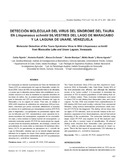| dc.rights.license | http://creativecommons.org/licenses/by-nc-sa/3.0/ve/ | |
| dc.contributor.author | Fajardo, Carlos | |
| dc.contributor.author | Rodulfo, Hectorina | |
| dc.contributor.author | De Donato, Marcos | |
| dc.contributor.author | Manrique, Ramón | |
| dc.contributor.author | Boada, Mélida | |
| dc.contributor.author | Aguado García, Nieves | |
| dc.date.accessioned | 2010-11-08T16:00:55Z | |
| dc.date.available | 2010-11-08T16:00:55Z | |
| dc.date.issued | 2010-10-31 | |
| dc.identifier.issn | 0798-2259 | |
| dc.identifier.uri | http://www.saber.ula.ve/handle/123456789/31773 | |
| dc.description.abstract | En Venezuela se detectó la presencia del Virus del Síndrome del
Taura (VST) en camaroneras del Lago de Maracaibo, estado Zulia
en 2004. Cerca del 90% de la producción total se vio afectada,
y a pesar que la situación parece haber sido estabilizada es necesario
conocer si el virus se mantiene en especies silvestres de
las áreas de cultivo. Así, se planteó aplicar técnicas moleculares
para la detección del VST en camarones silvestres del Lago de
Maracaibo y de la Laguna de Unare. Para esto, se extrajo el
ARN a 600 muestras de cefalotórax de camarones (300 por localidad),
colectados por pesca comercial, utilizándose la reacción
en cadena de la polimerasa por transcriptasa reversa (RT-PCR)
para el diagnóstico. Los ejemplares no presentaron signos clínicos
de infección por VST, característicos como ausencia de lesiones
necróticas del exoesqueleto, expansión de los cromatóforos
rojos y todos tuvieron la dureza normal del exoesqueleto. La
detección molecular usando RT-PCR de ronda simple fue negativa
para todas las muestras analizadas, sin embargo, a través del
procedimiento de ronda doble se detectaron 56 individuos infectados
(18,7% de prevalencia) en ejemplares de L. schmitti del
Lago de Maracaibo, mientras que no se detectó ningún ejemplar
infectado de la laguna de Unare. Este estudio representa el primer
reporte de infecciones asintomáticas del VST en poblaciones
silvestres de L. schmitti en Venezuela. | es_VE |
| dc.language.iso | es | es_VE |
| dc.publisher | SABER-ULA | es_VE |
| dc.rights | info:eu-repo/semantics/openAccess | |
| dc.subject | VST | es_VE |
| dc.subject | L. schmitti | es_VE |
| dc.subject | RT-PCR | es_VE |
| dc.subject | PCR anidada | es_VE |
| dc.title | Detección molecular del virus del síndrome del Taura en Litopenaeus Schmitti silvestres del lago de Maracaibo y la Laguna de Unare, Venezuela | es_VE |
| dc.title.alternative | Molecular Detection of the Taura Syndrome Virus in Wild Litopenaeus schmitti from Maracaibo Lake and Unare Lagoon, Venezuela | es_VE |
| dc.type | info:eu-repo/semantics/article | |
| dc.description.abstract1 | The Taura Syndrome Virus (TSV) was first reported in Venezuela
in 2004, in Maracaibo Lake, Zulia State. Nearly 90% of
the total production was affected, and although the situation
seems to be “under control”, it is important to determine the
presence of TSV in natural populations of wild shrimp from areas
of shrimp culture. Thus, molecular techniques were used
to detect TSV in wild shrimp from Maracaibo Lake, and Unare
Lagoon. For this, RNA was isolated from cephalothoraxes of
600 shrimp (300 from each locality), collected from commercial
fisheries, using reverse transcriptase polymerase chain reaction
(RT-PCR) for the diagnosis. The shrimp did not show clinical
signs of TSV infection, such as necrotic lesions in the exoskeleton,
expansion of red chromatophores, and all had normal
hardening of the exoskeleton. The molecular detection using
single round RT-PCR was negative for all the analyzed samples,
but after a second round of amplification, 56 infected
shrimp were detected from Maracaibo Lake (prevalence of
18.7%), while no infected shrimp were detected in Unare Lagoon.
This is the first report of asymptomatic TSV infections in
wild populations of L. schmitti in Venezuela. | es_VE |
| dc.description.colacion | 457 - 466 | es_VE |
| dc.description.edicion | SABER-ULA | es_VE |
| dc.description.email | marcosdedonato@yahoo.com | es_VE |
| dc.description.email | nievesaguado@yahoo.com | es_VE |
| dc.description.frecuencia | Bimestral | |
| dc.identifier.depositolegal | 199102ZU46 | |
| dc.publisher.pais | Venezuela | es_VE |
| dc.subject.institucion | Universidad del Zulia (LUZ) | es_VE |
| dc.subject.institucion | Universidad de Los Andes (ULA) | es_VE |
| dc.subject.keywords | TSV | es_VE |
| dc.subject.keywords | L. schmitti | es_VE |
| dc.subject.keywords | RT-PCR | es_VE |
| dc.subject.keywords | Nested RT-PCR | es_VE |
| dc.subject.seccion | Revista Científica: Fauna Silvestre | es_VE |
| dc.subject.thematiccategory | Medio Ambiente | es_VE |
| dc.subject.tipo | Revistas | es_VE |
| dc.type.media | Texto | es_VE |


